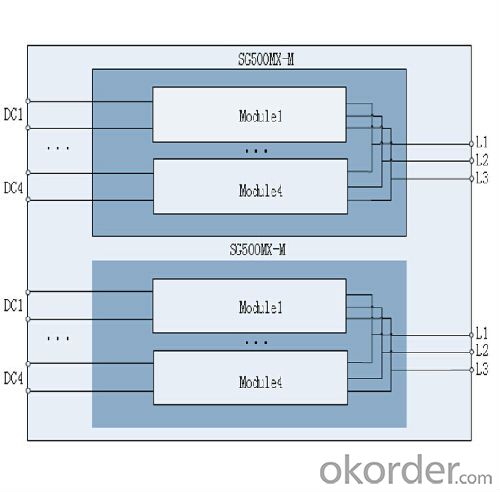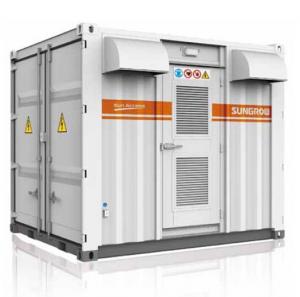Photovoltaic On-Grid Connected Inverter SG1000TS-M PV inverter
- Loading Port:
- China Main Port
- Payment Terms:
- TT or LC
- Min Order Qty:
- 500000 unit
- Supply Capability:
- 3000000 unit/month
OKorder Service Pledge
OKorder Financial Service
You Might Also Like
1. Structure of Photovoltaic On-Grid Connected Inverter SG1000TS-M PV inverter Description
A solar inverter, or PV inverter, or Solar converter, converts the variable direct current (DC) output of a photovoltaic (PV) solar panel into
autility frequency alternating current (AC) that can be fed into a commercial electrical grid or used by a local, off-grid electrical network.
It is acritical BOS–component in a photovoltaic system, allowing the use of ordinary AC-powered equipment. Solar inverters have
special functions adapted for use with photovoltaic arrays, including maximum power point tracking and anti-islanding protection.
Suitable for 50Hz/60Hz grid, could be used in Europe, Middle East Asia, Southeast Asia and Australia.
2. Main Features of the Photovoltaic On-Grid Connected Inverter SG1000TS-M PV inverter
• 7 square meters area for megawatt-class equipment
• Transport and installation by forklift, more flexible and economical
• Open door design of four sides, easy for installation and maintenance
• More flexible for inner devices overall replacement
• Efficient cooling patented design of combination inline and ventilation
• Patented structure design of inlet and outlet, effective dust proof
• Thick and efficient heat insulation layer
• Advanced three-level circuit structure improves product performance
• 8-MPPT, wide MPP voltage range, Flexible setting of 2 /4/ 8 MPPT
• Comprehensive modular ,Draw-type design
3. Photovoltaic On-Grid Connected Inverter SG1000TS-M PV inverter Images


4. Photovoltaic On-Grid Connected Inverter SG1000TS-M PV inverter Specification
Input (DC) |
|
Max. DC power (@ cos φ =1) | 1120kW |
Max. input voltage | 1000V |
Start voltage | 520V |
Min. working voltage | 500V |
Max. input current | 2280A |
MPPT voltage range | 500~850V |
Number of MPPTs | 2, 4, 8 |
Number of DC inputs | 2 x 8 |
|
|
Output (AC) |
|
Rated power | 1000kW |
Max. output AC power | 1100kVA |
Max. output current | 2036A |
THD | <3%(at nominal power) |
Nominal AC voltage | 315V |
AC voltage range | 252~362Vac |
Nominal grid frequency | 50Hz / 60Hz |
Grid frequency range | 47~52Hz / 57~ 62 Hz |
Power factor | >0.99@default value at nominal power, adj. 0.9 overexcited ~0.9 underexcited |
Isolated transformer | No |
DC current injection | <0.5% In |
|
|
Efficiency |
|
Max. efficiency | 98.80% |
European efficiency | 98.60% |
|
|
Protection |
|
DC disconnect device | Switch-disconnector with fuses |
AC disconnect device | Switch-disconnector with fuses |
DC overvoltage protection | Yes |
AC overvoltage protection | Yes |
Grid monitoring | Yes |
Ground fault monitoring | Yes |
Overheat protection | Yes |
Insulation monitoring | Yes |
|
|
General Data |
|
Dimensions(W×H×D) | 2991X2591X2438mm |
Weight | Containing DC Distribution Cabinet: 5169kg, Not Containing DC Distribution Cabinet: 4834kg |
Operating ambient temperature range | -35~+50℃ |
External auxiliary supply voltage | 380V |
Cooling method | Temperature controlled air-cooling |
Ingress protection rating | IP54 |
Allowable relative humidity range | 0~95%, non -condensing |
Max. operating altitude | 6000m (derating > 3000m) |
Communication port/protocols | Standard: RS485/ Modbus, Internet Options: CDT, DNP3.0, 101, 103, 104, GPRS/CDMA module |
5. FAQ of Photovoltaic On-Grid Connected Inverter SG1000TS-M PV inverter
Q1. What is the difference between inverter and solar inverter?
A1. Inverter only has AC inpput, but solar inverter both connect to AC input and solar panel, it saves more power.
Q2. What is the difference between MPPT&PWM?
A2. MPPT has higher efficiency, it can track the max power point and won't waste energy.
- Q:Can a solar inverter be used with a solar-powered EV charging network?
- Yes, a solar inverter can be used with a solar-powered EV charging network. A solar inverter converts the direct current (DC) electricity generated by solar panels into alternating current (AC) electricity, which is used to power electric vehicles (EVs) through the charging network. This allows for the efficient and sustainable use of solar energy to charge EVs.
- Q:How does a solar inverter convert DC to AC power?
- A solar inverter converts direct current (DC) power generated by solar panels into alternating current (AC) power that can be used to power appliances and feed into the electrical grid. It does this through a two-step process. Firstly, the DC power from the solar panels is converted into a high-frequency AC signal using power electronics. Then, this AC signal is transformed into the desired AC output voltage and frequency using pulse width modulation techniques. This allows for efficient and reliable conversion of solar energy into usable electricity.
- Q:How does a solar inverter handle voltage rise in case of low load conditions?
- A solar inverter handles voltage rise in case of low load conditions by reducing the power output from the solar panels. It does this by adjusting the voltage and frequency of the electricity generated, ensuring that the voltage remains within the acceptable range. This prevents any damage to the inverter or connected devices and ensures the efficient operation of the solar system.
- Q:How does a solar inverter handle voltage unbalance?
- A solar inverter handles voltage unbalance by continuously monitoring the phase voltages of the grid. If a voltage unbalance occurs, the inverter adjusts its output voltage and frequency to maintain a balanced supply to the grid. This ensures that the solar inverter can efficiently convert the DC power generated from the solar panels into AC power that is synchronized with the grid, despite any voltage imbalances.
- Q:How does a solar inverter handle power factor correction?
- A solar inverter handles power factor correction by using advanced control algorithms and circuitry to actively manage and adjust the power factor of the electrical output. It does this by continuously monitoring the load and adjusting the phase angle and voltage to ensure that the power factor remains close to unity (1.0). This helps optimize the efficiency of the solar system and ensures that the power being generated is in sync with the grid requirements.
- Q:What is the typical size and weight of a solar inverter?
- The typical size and weight of a solar inverter can vary depending on the capacity and type of the inverter. However, most residential solar inverters have dimensions ranging from around 12 x 8 x 5 inches and weigh between 20 to 40 pounds. Commercial or utility-scale inverters can be much larger and heavier, often weighing several hundred pounds and having larger dimensions.
- Q:What is the difference between a string inverter and a micro inverter?
- A string inverter is a type of solar inverter that is connected to a series of solar panels, converting the DC power produced by the panels into AC power for use in homes or businesses. A micro inverter, on the other hand, is installed on each individual solar panel, converting the DC power into AC power at the panel level. The main difference between the two is that a string inverter handles the entire string of panels, while a micro inverter operates on a per-panel basis. This means that micro inverters offer advantages such as increased energy production, better module-level monitoring, and improved system flexibility, but they can also be more expensive and complex to install compared to string inverters.
- Q:Can a solar inverter be integrated with a smart home system?
- Yes, a solar inverter can be integrated with a smart home system. This integration allows for monitoring and controlling the solar energy production, as well as optimizing energy usage and managing the overall efficiency of the system.
- Q:What is the role of a frequency regulation feature in a solar inverter?
- The role of a frequency regulation feature in a solar inverter is to maintain a stable and consistent frequency of the electrical output, ensuring compatibility with the grid or connected appliances. This feature helps to mitigate fluctuations in frequency caused by varying solar irradiance or load fluctuations, thereby improving the overall efficiency and reliability of the solar power system.
- Q:Can a solar inverter be used for both residential and commercial applications?
- Yes, a solar inverter can be used for both residential and commercial applications. Solar inverters are designed to convert the direct current (DC) electricity generated by solar panels into alternating current (AC) electricity, which is suitable for use in homes and businesses. They are versatile and can be scaled up or down depending on the size of the solar power system, making them suitable for both residential and commercial installations.
1. Manufacturer Overview |
|
|---|---|
| Location | |
| Year Established | |
| Annual Output Value | |
| Main Markets | |
| Company Certifications | |
2. Manufacturer Certificates |
|
|---|---|
| a) Certification Name | |
| Range | |
| Reference | |
| Validity Period | |
3. Manufacturer Capability |
|
|---|---|
| a)Trade Capacity | |
| Nearest Port | |
| Export Percentage | |
| No.of Employees in Trade Department | |
| Language Spoken: | |
| b)Factory Information | |
| Factory Size: | |
| No. of Production Lines | |
| Contract Manufacturing | |
| Product Price Range | |
Send your message to us
Photovoltaic On-Grid Connected Inverter SG1000TS-M PV inverter
- Loading Port:
- China Main Port
- Payment Terms:
- TT or LC
- Min Order Qty:
- 500000 unit
- Supply Capability:
- 3000000 unit/month
OKorder Service Pledge
OKorder Financial Service
Similar products
New products
Hot products
Hot Searches
Related keywords































